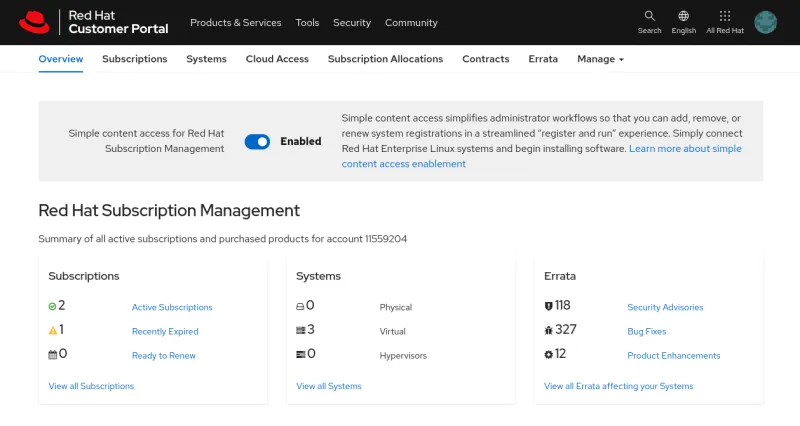In my time as a technical account manager (TAM), I have noticed a fair amount of confusion and frustration associated with handling Red Hat Enterprise Linux (RHEL) subscriptions. You have infrastructure to manage, customers to support, and management to answer to. Worrying if your systems can consume Red Hat content pulls your attention away from critical tasks your organization needs to perform.
To address this, Red Hat has invested in significant tooling to ensure you get maximum value from your subscriptions without having to manually entitle every RHEL system individually. These tools include Simple Content Access (SCA), the Subscription Service, and System Purpose.
What is Simple Content Access?
Simple Content Access (SCA) is a capability in Red Hat’s subscription tools which simplifies the behavior of the entitlement tooling, making it easier to consume the content provided by your Red Hat subscriptions without the complexity of configuring subscription tooling.
Access content anywhere, anytime
With Simple Content Access enabled, entitlements no longer need to be attached to every individual system in order to download and install content from Red Hat. RHEL systems can consume content without an entitlement being attached to them.

SCA toggle in the customer portal
This can prevent one of the common interruptions I see while acting as a trusted advisor for my customers. The interruption begins with a customer trying to deploy a new system. For example, it could be the rollout of a new node in a high-availability cluster or a new instance of RHEL that a critical service will be residing on. When the customer tries to attach the necessary subscription, they notice that they have no more subscriptions available. Upon investigation, the customer might find that another team or organization accidentally consumed their subscription, or that it was auto-attached to the wrong system. A significant delay in their project deployment follows.
The customer is left with the difficult decision between “stealing” their subscription back from the other system or trying to purchase one quickly. Both options can be fraught with blockers and delays from organizational processes and procedures.
Okay, I enabled Simple Content Access. Now what?
Once my customers have enabled SCA, they often make one of two incorrect assumptions.
The first assumption is that because SCA is enabled, they no longer have any responsibility to track subscription utilization. This is not true. You still have a responsibility to validate that you are not over-consuming Red Hat Subscriptions. SCA is not an “all-you-can-eat” subscription. It merely removes the need to attach a subscription for a RHEL system to consume Red Hat content.
The second assumption is the complete opposite of the first. Some customers assume they need to take on the responsibility of tracking subscription utilization all on their own. They create makeshift spreadsheets with over 10,000 lines or custom plugins for their preferred CM tool. Red Hat has worked hard to give you options and frictionless ways to manage your subscription utilization.

Simple Content Access, The Subscription Service and System Purpose working together
How can Red Hat help me?
The Subscriptions Service is an online service provided to our customers at no charge. It can help you track your subscription utilization in an easy-to-digest format hosted in our Hybrid Cloud Console. Subscriptions Service provides a single pane where you can track your usage, capacity, and utilization of various Red Hat products, including RHEL. We provide visual representations of your subscription utilization, graphed over time. It can even pull in data from multiple public clouds and private clouds into a single source of truth for you. There is just one caveat: It requires that you register your RHEL systems to our subscription portal.

The Subscription Service RHEL graph
But I have an air-gapped environment!
Good news! We have other ways to help you track your utilization. Red Hat Discovery was created for just this purpose. It finds, identifies, and reports subscription relevant information from your air-gapped environments. Querying vCenter, OpenShift, Satellite, or individual systems helps Discovery gather a comprehensive list of RHEL systems in your environment. Using this information you can make more informed decisions about your subscription utilization.
My subscription count isn’t adding up. What gives?
I’ve seen two very common reasons for subscription reports from Subscriptions Service and Discovery to be inaccurate.
The first is because your systems do not have their System Purpose properly defined. This is what tells our reporting tools which systems are servers and which systems are workstations. Beginning in RHEL 8, the repositories for servers and workstations are identical. That is why it’s necessary for you to tell us how you intend to use these systems with system-purpose. This can be done from the command line, in our customer portal, or by using Red Hat Satellite, as documented here.
The second reason a subscription report might be inaccurate is related to host-based subscriptions. These subscriptions allow a host to entitle its guests. These guests don’t need their own subscription because they “inherit” one from their hypervisor. These guests aren’t able to gather any information from their host so we need to gather that information some other way.
That’s where virt-who comes to the rescue. Virt-who generates a host to guest mapping. Our reporting tools can use this information to ensure we aren’t assuming these virtual guests need their own subscription.
I still need help. Who can I reach out to?
Your Red Hat technical account manager is the perfect resource to help solve your subscription reporting challenges. If you don’t have a TAM, reach out to your Red Hat solution architect (SA) or customer success executive (CSE).
We want you to get the most out of your Red Hat subscriptions and to help ensure you are spending your time on what really matters: supporting your customers.
About the author
Zach Connor has been a Technical Account Manager with Red Hat since 2021. When he isn't tinkering with technology, he loves adventuring in the Colorado outdoors with his wife and two daughters.
More like this
Data-driven automation with Red Hat Ansible Automation Platform
Accelerating NetOps transformation with Ansible Automation Platform
Technically Speaking | Taming AI agents with observability
Ready To Launch | Compiler
Browse by channel
Automation
The latest on IT automation for tech, teams, and environments
Artificial intelligence
Updates on the platforms that free customers to run AI workloads anywhere
Open hybrid cloud
Explore how we build a more flexible future with hybrid cloud
Security
The latest on how we reduce risks across environments and technologies
Edge computing
Updates on the platforms that simplify operations at the edge
Infrastructure
The latest on the world’s leading enterprise Linux platform
Applications
Inside our solutions to the toughest application challenges
Virtualization
The future of enterprise virtualization for your workloads on-premise or across clouds
